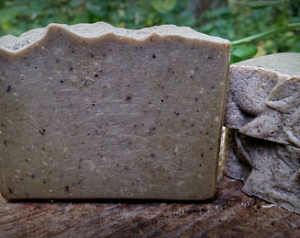
Dead Sea Mud Soap contains the salt and mud from the Dead Sea which are known to be beneficial for our skin and bodies. Just soaking in a bath of Dead Sea Salt once a week can help to remove toxins from our body….so why not clean with a bar of soap made with this wonderful mud.
Where to purchase Dead Sea Mud
This recipe should give you about 3 lbs of soap which translates into about 15 good size bars.
- 850 Grams Olive Oil
- 300 Grams Coconut Oil
- 250 Grams Palm Oil
- 75 Grams Castor Oil
- 15 Grams Jojoba Oil
- 11 Grams Cocoa Butter
- 11 Grams Shea Butter
- 202 Grams Sodium Hydroxide (LYE)
- 2 Cups of Water
- 30 Grams Dead Sea Mud
If you want to scent this soap it will require approximately 1 ounce of scent. I don’t scent mine, but that’s just my personal preference.
Make you soap as usual – you can follow the Step by Step Instructions if you want, or the instructions at the bottom of this page.
Add 30 grams of Dead Sea Mud to your soap at trace.
For more information on Dead Sea Mud and it’s Benefits go to Dead Sea Mud Benefits
Westlab’s Dead Sea Mineral Mud – Purifying, Soothing & Detoxifying – Resealable Pouch
Basic Cold Process Soap Making Instructions
Before starting gather all the equipment and ingredients you will need for you soap
Mixing your ingredients:
- Put on your protective clothing, apron, safety goggles, gloves etc
- Measure your water and pour it into the container you will be using for your lye/water mix
- Measure out your lye (sodium hydroxide)
- Slowly add the lye to the water, stirring to be sure it mixes well. This should be done in a well ventilated area as the fumes can be quite strong. This will only last for a 15 seconds or so. Stir until the lye is completely dissolved in the water. It will heat up to about 180 degrees and can now be put aside to cool down.
- While the lye/water is cooling use a scale and measure each of your soap oils and put into your stainless steel pot.
- Place this pot on your stove or hot plate and turn on low to heat to approximately 130 degrees.
- Once the oils have heated to 130 degrees take off the stove or hot plate and let them cool down to about 100 degrees.
- When the lye/water mix and the oils are both cooled down to about 100 degrees they are ready to be mixed.
- Slowly add the lye/water mix to your soap oils and stir you can use a stick blender and hand mix. Mix the soap until it traces. This is when the soap begins to thicken; you can test this by using your spoon to drizzle the liquid into the pot. You will see a trace that stays on the surface of the soap mixture.
- Once the soap has traced this is the time to add your scent and color.
- Mix the scent and color in well
- Pour this mixture into the lined molds, cover with a piece of cardboard or plastic, put it to bed (place a blanket over the soap mold) and let set for a day or two.
- Once it has sit for a day or two, remove the soap from the mold and cut and put out to cure for 4 to 6 weeks.
#handmadesoap #naturalsoap #makingsoapnaturally #soapmaking #soapmaking #soaps #artisansoap #bathandbody #cpsoap #coldprocesssoap #etsy #soapbase #soapcrafter #soapmaker #soaping #soapcrafting #soaphandmade #soap #giftidea #christmas #barsoap #handmadesoap #natural #organic #skincare #coldprocess #deadseasalt #deadseamud #deadseamudsoap
© 2017 – 2019, Tes. All rights reserved.

Thanks for this Great recipe & tutorial.
Being a very impatient person, I’ve discovered I prefer the Hot Process Soap method over Cold Process. I’ve read in my different E-Course soap making books, any cold process soap recipe can be done as Hot Process..I’m gonna try this with the “Hot Process” method ?